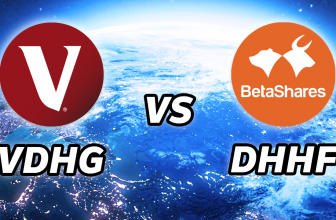Up until fairly recently it was actually a massive pain to invest directly into US stocks and as a result Australian investors have been mostly focused on stocks available in Australia on the ASX. That’s because not many brokers offered US stocks and if they did it was pretty expensive. Even today most Australian stock portfolios would typically consist of the big 4 banks, CSL, BHP and maybe a few speculative options like Zip or Afterpay.
Well now you don’t need to restrict yourself to stocks within just Australia, these days you can buy and sell stocks from all over the world including the biggest exchanges in the United States (Nasdaq and NYSE). So let’s go over everything you need to know to get started with buying US stocks if you reside in Australia, including why you should even consider buying US stocks, things to be careful about when buying US stocks, what are the best US stock brokers to use (need to be careful with fees here), how to actually buy a US stock, and then finally some other ways to own US stocks without buying them directly via a US stock exchange.
Why buy US stocks?
Global diversification
So to kick off, the biggest reason why you might want to invest in the US is that it’s the largest stock market in the world by a huge margin, making up over 55% of the global stock market share. And we find that Australia’s stock market is pretty small in the grand scheme of things with just 2% share of the global market. Which means if you want to be properly diversified across global markets, you’ll need to consider investing outside of the ASX. This is also the reason why we generally see that the ASX is heavily influenced by the US’ trading session the night prior, if the US had a positive trading day we generally see the ASX to open positive and vice versa.
Sector diversification
Even if you don’t necessarily care about being globally diversified, another reason why you might want to think about investing in the US markets is for industry diversification. If we look at the sector breakdowns for the ASX200, we find that it is highly concentrated on 2 industries, financials and resources.
Compare this with the S&P 500 which shows a lot more diversification across multiple sectors. Where we see multiple different industries having at least a 10% share of the overall pie.
US share performance vs Australian share performance
For those of you who don’t care about diversification and just want the best performance, this is also another reason to consider US stocks. If we look at a report from Vanguard showing the performance of US shares vs Australian shares over the last 30 years, we find that Australian shares have actually performed extremely well in the global markets, with a 8.9% p.a return vs. a 10.3% p.a return from US shares. Whilst this doesn’t seem like a lot, if you invested $10,000 30 years and re-invested all the dividends, you would actually have a difference of over $50,000 if you picked the US shares over the Australian shares.
As Vanguard highlights in their report, the data shows the importance of diversifying investments to help reduce volatility and receive more consistent returns. All of the asset classes shown have had periods of outperformance, and periods of underperformance. Recessions, disasters and wars can strike without warning, sending specific countries’ markets plummeting.
US ETFs have lower fees
Now finally the last reason why you might want to consider US stocks is one that I’m sure everyone will care about, and that is that they typically have lower fees on like-for-like index funds or ETFs. Just one example is for the very popular NDQ ETF available on the ASX which tracks the NASDAQ-100 Index, this ETF has a management fee of 0.48% p.a. The QQQ ETF available in the US which tracks the very same Index, has a management fee of 0.20% p.a. The reason we usually see this is because they have far greater scale which lowers costs and also because the ETF market is a lot more competitive, which further drives costs down.
Things to watch out for when investing in US stocks
In saying that, whilst US shares are definitely something all investors should consider, there are a few things you need to keep in mind before jumping straight in.
No CHESS in the US
The first thing is that unlike Australia, there is no form of CHESS holding sponsorship in the US. They don’t have a HIN, and all shares are held via the custodian model. If you’re unfamiliar with CHESS and why it’s important, check out my post on ASX brokers, where I explain this in detail. But basically it’s a super secure way of stock ownership, which they don’t have in the US, meaning if your broker happened to go bust, there’s a chance you might lose some or all of your holdings.
Tax implications of US stock holdings
Second, is that there are some additional tax implications if you hold US shares directly. You’ll need to complete a W-8 US tax form, to ensure you aren’t taxed more than you should be. If you don’t, 30% of your sale proceeds will be withheld by the IRS (US equivalent of the ATO).
A W-8 form is required for each U.S. holding. A correctly completed form is valid for three years. However, there is a requirement to submit an updated form when any of your circumstances change (e.g. name or address).
Anyways, this is simple enough, just complete the form once every 3 years and you’ll be okay.
Performance impacted by currency fluctuations between USD/AUD
Finally the last thing to consider when investing in US stocks, is that you’ll be exposed to fluctuations between the US dollar and the Australian dollar. If the Aussie dollar goes up vs. the US dollar, your US stock holding performance is effectively reduced and vice versa.
How to buy US stocks in Australia
Find a stock broker
Now, if you have weighed up all those things and still want to go ahead with buying US stocks, then the first thing you will need to do is find a stock broker that allows Australians to buy US stocks.
There’s literally dozens of different investing platforms that will allow you to buy US stocks. And you need to consider a lot of different things when choosing the right one for you, the main things being, the brokerage fee (how much it will cost you to buy and sell stocks), the foreign exchange fee (to buy US stocks you will need to transfer your USD into AUD), any additional account keeping fees, minimum deposits, and how usable they are in terms of user experience. To save you some time I won’t go through every single one but I will share what I think are a few of the best brokers to use depending on whether you’re a beginner or a more advanced investor.
If you’re an absolute beginner to investing or if you actually just want to use an interface that isn’t overwhelming and complicated, then my favourite investing platform to buy US stocks is Superhero or Stake. They both have $0 brokerage on US stocks and relatively low FX fees, with no additional account keeping fees. Superhero has slightly lower foreign exchange fees at 0.50%, with Stake’s at 0.70% but Stake has been around for quite a bit longer and I would consider their app a bit easier to use. They both don’t have any account keeping fees and would be good options to start out with.
Stake is one of the easiest ways to start buying US shares with $0 brokerage, use my referral link for 1 free stock, valued up to $100.
If you’re a more advanced user and don’t mind using a more complicated interface and having to deal with a complex fee structure then the best broker to use to buy US stocks (and most international equities) will be Interactive Brokers. Foreign exchange is done practically at the spot rate and the brokerage fees are very low (but again very complicated).
Open and fund your account
Now once you’ve chosen the broker that you want to use to buy US stocks, then the next thing you will need to do is to open and fund your account. This is usually pretty straightforward but an annoying step that you’ll just need to do. This application process can take as little as a few minutes to a few weeks depending on the broker.
After you’ve signed up you’ll need to top up your account, this is usually a bank transfer but it could also be a credit card transfer, paypal or debit card and the broker will usually open up a US bank account for you under your name so it pays to be aware of that.
Invest in US stocks
Now that you’ve opened an account and have funds in it, you can finally start investing in US stocks. The stocks to invest in is really up to you and your situation, but for me it makes sense to look at diversifying into things I can’t get access to in the ASX, namely large technology companies, like Apple, Facebook and Google. And I’d also look at low cost ETFs like QQQ that I mentioned earlier.
Other ways to buy US stocks
If that all sounds too complicated or too much effort, there are actually ways to invest in US stocks without going through a US stock broker.
ETFs on the ASX with US exposure
Firstly you can use ETFs that are available in Australia on the ASX that have US exposure, of which there are a whole list of, some that are completely focussed on the US market alone like SPY or NDQ. And then there are others that are more globally diversified that will have US market exposure in them, like VDHG or DHHF.
Micro investing apps or Robo advisor investing apps
Finally, the last thing you could also do is use a micro-investment app or robo advisor app, like Spaceship (WalletLab readers can use code S8DYRGIE1Z for a bonus $10) or Raiz (WalletLab readers get a bonus $5 using this referral link). Check out my post where I compared these micro investing apps in great detail going over all the pros and cons. But basically these micro investing apps will allow you to choose to invest in specific portfolios which will often contain a lot of US stocks or US ETFs, giving you exposure to the US market.
Spaceship Voyager: WalletLab readers get a bonus $10 when signing up using the code: S8DYRGIE1Z
Next steps
Now you’re pretty much done, all that’s left to do is to keep investing for the long term and occasionally check on the performance of your stocks. Otherwise you’ll get sucked into the short term highs and lows and probably make mistakes like trying to time the market.








ETFs on the ASX with US exposure
It will be great if you could please publish a list of those that mimic SPY and QQQ for example.
Cheers, LD